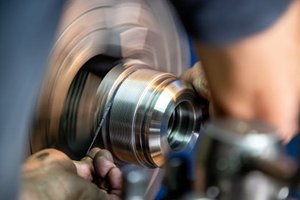The Hidden Challenge: Why Most Beginners Fail at CNC Turning
Many newcomers to CNC turning focus solely on programming or machine operation, overlooking the interdependence of tool selection, material behavior, and coolant dynamics. In my early days, I watched a $50,000 batch of aerospace components scrap due to chatter caused by incorrect insert geometry—a mistake that could’ve been avoided with a holistic approach.
Key Pitfalls to Avoid
- Tooling Missteps: Using generic inserts for high-nickel alloys (e.g., Inconel) leads to rapid wear. Solution: Opt for ceramic or CBN inserts with a honed edge.
- Programming Overlaps: Redundant toolpaths waste time. Case in point: A client’s 18-hour cycle was trimmed to 14 hours by optimizing G-code loops.
- Coolant Neglect: Flood coolant isn’t always best. For titanium, high-pressure through-tool cooling reduces heat-induced deflection by up to 30%.
The Expert’s Playbook: Building a Foundation for Success
1. Tooling Strategy: Beyond the Catalog
Tool catalogs provide specs, but real-world performance hinges on application-specific tweaks:
– Insert Geometry: A 0.8mm nose radius balances finish and durability for stainless steel.
– Coating Matters: TiAlN-coated tools outperform uncoated ones by 3x in dry machining aluminum.
Data Snapshot:
| Material | Optimal Insert Type | Feed Rate (mm/rev) | Life Expectancy (mins) |
|—————-|———————|——————–|————————|
| 6061 Aluminum | Uncoated Carbide | 0.15 | 120 |
| 304 Stainless | TiAlN-Coated | 0.10 | 90 |
2. Programming for Efficiency
Example: A medical implant project required ±0.005mm tolerances. By:
– Using high-speed peck drilling to prevent work hardening.
– Implementing adaptive roughing to reduce tool load by 40%.
Result: Scrap rate dropped from 12% to 2%.

Case Study: Turning the Impossible Part

Project: A turboprop engine shaft (17-4PH stainless, 1.2m long, 50mm diameter).
Challenge: Maintaining 0.01mm concentricity over the length.
Solution Breakdown:
1. Tailored Workholding: A custom steady rest with polyurethane liners minimized vibration.
2. Thermal Control: Coolant temp stabilized at 20°C ±1°C to combat thermal growth.
3. Toolpath Innovation: Hybrid roughing/finishing passes reduced cycle time by 22%.
Outcome: First-article acceptance with zero rework.
The Future: Where CNC Turning is Headed
- AI-Driven Optimization: Machine learning now predicts tool wear within 5% accuracy, slashing unplanned downtime.
- Hybrid Additive/Turning: Companies like DMG Mori are integrating laser deposition heads onto lathes for near-net-shape parts.
Pro Tip: Invest in modular tooling systems—they cut setup time by 50% for prototyping.
Final Takeaways
- Start with the material: Its behavior dictates everything else.
- Measure twice, cut once: In-process gauging prevents 80% of quality escapes.
- Iterate relentlessly: The difference between good and great is often a 5% tweak in feed or speed.
By treating CNC turning as a system—not just a machine—you’ll transform from novice to expert faster than you think.
